RV campers are known for using a lot of technical jargon, slang, and their own lingo. Our RV dictionary will explain what it all means in this ultimate compilation of RVing terms.
Table of Contents
RV Types and Names
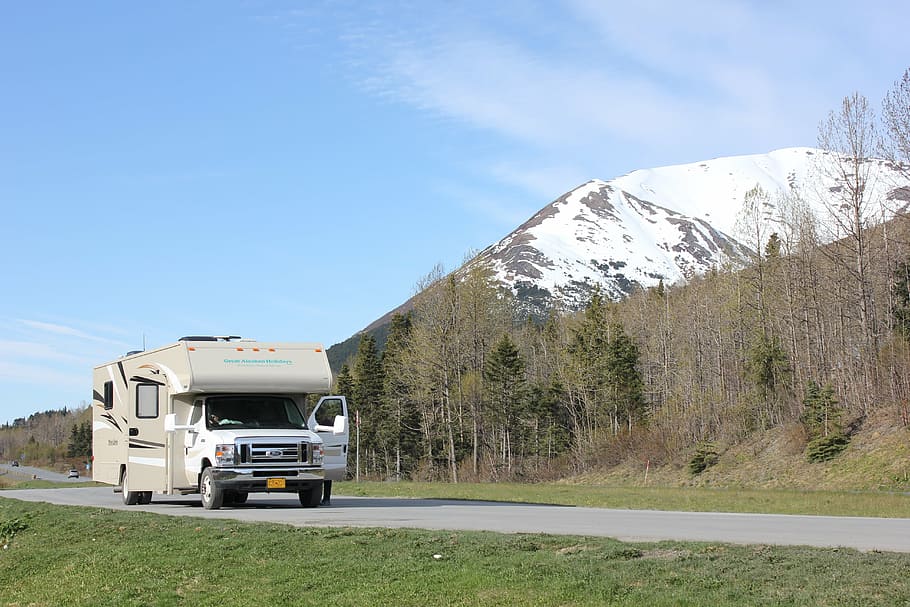
RV (Recreational Vehicle)
RV applies to any motorhome, camper van, truck camper, trailer, toy hauler or fifth wheel. If it is a vehicles that you a can camp in, then the term RV can describe it.
Rig
Another term for any type of RV. When applied to towables (trailers and 5th wheels), it can also sometimes include the entire setup of the tow vehicle and the towable.
Camper
This one will depend on who is using it. Some will use it as another term for motorhome. Some will use it to describe a trailer. And some will mean it to be specifically a truck-bed camper. So for this one, you may need to clarify with the speaker if you need to know more details other than it is some sort of RV.
Class A
This is the technical designation given to a motorhome that is built on a heavy-duty frame that is a commercial bus chassis, a commercial truck chassis, or a motor vehicle chassis. They typically have a flat front, and a large amount of storage under the unit.
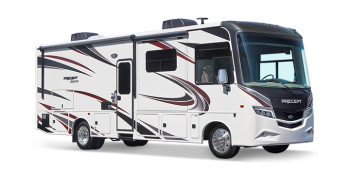
Class B
This is the technical designation given to a camper van. A class B is built within the standard stock framework of a van, with only minor exterior modifications, with all the camping conversions done inside. Some will however have a raised roof and/or a dropped floor to provide additional headroom.
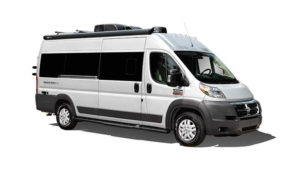
Class Super B or B+
A Super B is vague designation given to a camper van that is still a van conversion but typically has additional exterior modificatons and may extend beyond the stock width in the living area. They do not have over-cab sleeping areas like a Class C.
Class C
This is the technical designation given to a motorhome that is built on a van or truck chassis. The driving cab still uses the standard van or truck structure, with the camping portion built on the cargo section. They are typically easily identified by the cabover sleeping area about the driving cab.
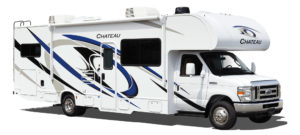
Class Super C
A Super C is similar to a Class C, but is built on a much larger chassis and has larger engine, such as an F-550 or E-450. But it still has the stock driver cab and usually the overcab sleeping area.
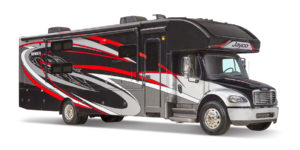
Motorhome (Gas and Diesel)
A motorhome is a camping vehicle that is self powered with an engine. The variety can be significant, but the consistent theme is the driving area and the camping area are directly connected by access and area single vehicle. This section and our glossary covers some of the variety of motorhomes and names.
Travel Trailer ( TT ) – Camper Trailer
A trailer is a separate camping unit from the tow vehicle and can be pulled by a car, van or truck. Typically a trailer is used to described by a unit that is pulled by a hitch located below the back bumper, hence the nickname, “bumper pulls.” They can be very small, like the Airstream Nest, or quite long with multiple doors and slideouts.
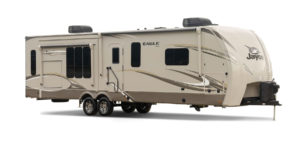
5th Wheel ( Fifth Wheel, 5er)
Technically also a trailer, fifth wheels get their name from their special method of hitching. Hitches are placed in the bed of a pickup truck using a large pin that pivots on a flat plate, hence the idea of an “additional” wheel. They provide exceptional stability and turning characteristics by placing the front weight on the trailer between the tow vehicles axles as opposed to behind the vehicle like other types of trailers.
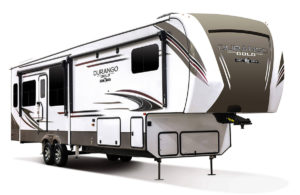
Toyhauler
A toyhauler includes a large multi-use area called a “garage” that can carry “toys” such as motorcycles, ATVs, kayaks, bikes, etc. Typically once set up, the toys are removed and the garage is converted to additional camping/sleeping space. Most toyhaulers are trailers or fifth wheels, but there are a few motorhome toyhaulers like the Thor Outlaw.
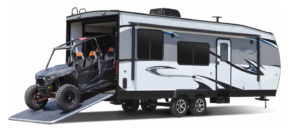
Caravan
In the US, this typically refers to a group of vehicles traveling together, but in British English, a caravan is a trailer that is towed by a standard vehicle.
Teardrop Trailer
And extremely small trailer that gets its name from usually being shaped like an aerodynamic teardrop. They typically do not include a bathroom and have an exterior kitchen in the rear. The main area is often just a sleeping area and some small amount of storage. They are good for vehicles with very small tow ratings, but are a nice step up from sleeping on the ground in a tent.
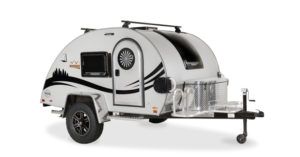
A-Frame Popup Trailer
A type of popup trailer typically with opposing hard roof panels that fold up to meet and form an “A” shape. They have the advantage over tent-style popups in that they have a hard exterior when extended, but they do sacrifice some headroom space with that design.
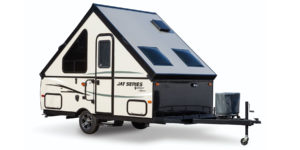
Pop Up (Tent Camper, PUP)
This is a hybrid trailer that expands once set up, usually using canvas or tent-style areas. Many include some features like cassette toilets and basic kitchens, but they are all located at waist level or below so that the top area can pack up compactly. One major benefit is the weight of pop up campers since many smaller vehicles can tow them.
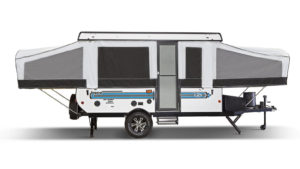
Hi-Lo Trailer
This is a specific type of pop up trailer that is all hard sided, but the the upper portion cleverly collapeses down into the lower portion when traveling. This creates some challenges with placement of items withing the trailer, but it does allow for some amazing aerodynamic qualities when towing.
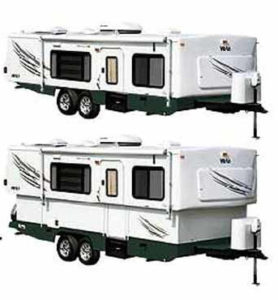
Bus Conversion
A general term for a motorhome that is built on a bus chassis. This can be a more typical-looking Class A motorhome built on a motorcoach chassis, or sometimes is a custom conversion done to a former school bus, which is slangly referred to as a “Schoolie.”
Truck Camper
Also called a Slide-In, Slide-On or Cab-Over, it’s a camper that slides into the bed of a truck, then slides out onto its own legs at the campsite. In spite of the “add-on” nature of these camper, they can be quite luxurious, with some boasting slide-slideouts, nice bathrooms and kitchens and necessary holding tanks.
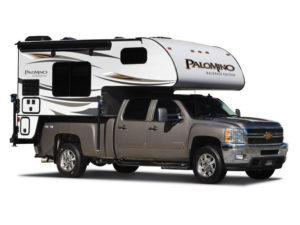
The Ultimate RV Dictionary
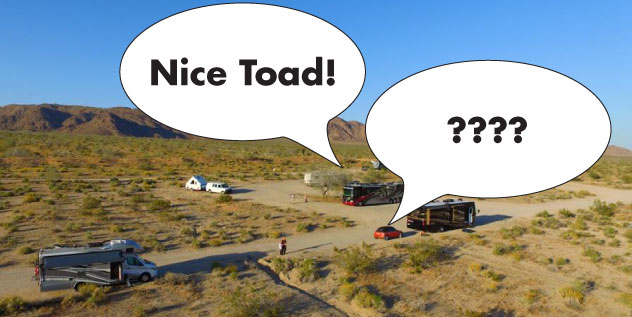
RV GLOSSARY OF TECHNICAL TERMS, SLANG & LINGO
We continue our dictionary with a glossary of technical jargon, slang and common lingo that RVers use. If you have a word or phrase to add to our RV dictionary, be sure to share with us in the comment section at the bottom of the page.
10 Year Rule
This is rule that RV resorts and private campgrounds will use to prohibit older and unsightly RVs from staying at the campgrounds. This is more common at higher end RV resorts. Exemptions are sometimes granted if you can send them a photo of a restored older model unit prior to placing a reservation.
15/20/30/50a
A campground that has electricity for RVs needing 15, 20, 30 and 50 amp service.
4-Pin Electrical Connector
This type of trailer connector provides power from your tow vehicle to your RV for the lights only.
7-Pin Electrical Connector
This type of connector provides power from your tow vehicle to your RV for the lights as well as the electrically operated brakes.
12V (12 Volt)
This refers to DC (direct current) power from your battery system. Typically it runs basics like lights, water pump, and gas appliance circuit boards. Even furnaces and propane refrigerators need some DC power in order to operate.
55 and up
This refers to a private RV campground rule where the RVers are all of a certain age (55 and up). Sometimes it refers to only one of a couple, but be sure to call ahead to find out the exact application of the rule. Activities and the amenities are not typically kid or family-friendly, but are more geared to older adults.
A
A-Frame (Trailer Type)
A type of popup trailer typically with opposing hard roof panels that fold up to meet and form an “A” shape. They have the advantage over tent-style popups in that they have a hard exterior when extended, but they do sacrifice some headroom space with that design.
A-Frame (On Trailers)
The front external portion of a trailer that includes the hitch coupler, front jack and often the propane tanks and batteries. The two arms meet at the hitch coupler forming an “A” shape, hence the name. It is also referred to as the tongue.
AGM Battery
This stands for Acid Gas Matte and is a sealed lead-acid battery often used in RVs because you don’t have to add water to cells and it doesn’t need ventilation.
Anode Rod
A rod, typically magnesium or aluminum, used in a steel water heater to attract corrosion-causing products in the water. Anode rods are usually not be installed in an aluminum tank.
A/C
This is just short hand for air conditioner.
AC Power
For RVs in the US, this is typically 120 volts of alternating current and is what you typically are provided in full hookup sites with varying amounts of amps.
Aluminum Exterior Sidewalls
This refers to the outside RV construction consisting of a wooden (or aluminum) framing with an aluminum exterior and batten insulation.
Auxiliary Battery
An extra battery to run your 12-volt equipment.
B
Back-up monitor
A camera mounted on the back of the RV that provides the driver with a backward view when backing up the RV, usually seen on a back-up monitor on or in the dashboard by the driver’s seat.
Back-in site
Back-in campsites require the RV driver to back up into them, as opposed to pull-through sites which can be driven in and out of by only driving forward.
Basement
The storage area below the main area of your motorhome or fifth-wheel that is accessed from the outside and below the living area. Generally trailers are not included in this terminology as the storage is on the same level as the living space.
Batwing
This is a nickname given to the crank-up style of TV antenna that has arms that resemble bat wings.
Big Rig
This refers to the largest RV and is usually referred to when asking if something is “Big Rig Friendly,” meaning it can accommodate long RVs with limited mobility.
Black Water Tank
Black water is the type of waste water that is produced from the RV toilet. On most rigs, it is kept in a separate tank from your other types of waste water.
Blue Boy
This is a brand name of a portable wheeled plastic tote used to transport waste tank sewage from the RV to the dump station. It is one of those brands that is commonly used to refer to all wastewater totes in informal usage. I can be pulled or towed at slow speed by the tow vehicle.
Box
This refers to a Class A motorhome’s “living area” built on the mechanical chassis.
Boondocking
Sometimes also called dry camping, boondocking refers to camping without any sources or external hookups, such as water, sewer and electricity, and usually involves dry camping in more remote areas outside of designated camping sites.
Brake Controller
A device inside a tow vehicle that will apply the trailer brakes simultaneously when the tow vehicle brakes. It is required in most states for larger towed RVs.
Breakaway Switch
This is a safety switch that is automatically activated and applies brakes on the trailer (or 5th wheel) if your trailer becomes separated from the tow vehicle. It requires a cable to the tow vehicle from the trailer that pulls a pin from the switch if it becomes separated.
Bricks and Mortar
A slang term used by RVers for a stationery business that resides at one specific location.
BTU (British Thermal Unit): A measurement of heat which is the quantity required to raise the temperature of one pound of water 1 degree F. BTUs are used to measure RV air conditioning and furnace output ratings.
Bumper Pull
Another name for a trailer that is pulled by a hitch at the bumper level (as opposed to a 5th wheel trailer, which is hitched in the bed of a truck).
Bunkhouse
A floorplan style of an RV that has bunk beds often in a separate room.
C
Caravan
In the US, this typically refers to a group of vehicles traveling together. In British English, a caravan is a trailer that is towed by a standard vehicle.
Cargo Carrying Capacity (CCC)
The maximum weight limit for personal items you can add to an RV.
Cassette Toilet
This type of toilet has a small holding tank (a cassette) that can be removed from outside the RV in order to empty it.
Chassis
The framework that supports the entire motorhome, and typically also includes the motor, wheels and drive train.
Chassis Battery
The battery in your motorhome that operates 12 volt engine and other components of the drivetrain.
Cockpit
The front area of your motorhome where the driver and front passenger sit, as well as the dashboard.
Converter
A converter converts 120 volt AC power to 12 volt DC power and also charges your 12 volt battery.
Chocks (Wheel Chocks)
Blocks or devices used to keep the RV wheels stationary and prevent the RV from rolling when parked.
Chucking
A violent back and forth motion that occurs during towing when a trailer is unbalanced trailer, there are suspension or wheel issues, or an uneven roadway.
City Water
A slang term that refers to water hookups for an RV. You are on city water when you have a water hookup and don’t need to use the on-board water pump, even if the water in the park is provided by a private well.
Coach (or Motorcoach)
Another name for a Class A RV, typically the larger “bus-sized” motorhomes.
Cockpit
Where the driver sits to drive in a motor home.
Curbside
The side of the RV that is nearest the curb when parked.
D
Demountable (Dismountable)
Another name for a truck camper in English-speaking European countries.
Deep Cycle Battery
These are batteries that are constructed to allow deeply discharging with minimal degradation of their capacity. Engine, or strarting batteries can be fairly quickly damaged by deep discharges. In spite of the name, minimizing the depth of discharge of deep cycle batteries will lengthen their service life. For example, a deep cycle lead acid battery shouldn’t be discharged below 50% to avoid significantly shortening its charge cycles and lifespan.
Dinette
The name for the booth-like dining area in an RV. Usually the table will be dropped to convert dinette into a bed at night if needed.
Dinghy (Toad or Towed) – The slang term for a vehicle that is being towed behind a motorhome.
Dispersed Camping
This refers to dry Camping or boondocking on public National Forest and BLM lands, in areas approved for camping, but where there is not a developed campground. Most National Forests and BLM (Bureau of land management) lands are open for dispersed camping with certain area and stay-length restrictions. Check with the regional federal recreation offices for more details for an area.
Driveway Surfing
A slang term for visiting friends or family and “camping” in their driveways.
Dry Camping
This is camping without hookups to any utilities. Power will come from the battery bank or from a generator, and water and sewer use the holding tanks.
Drydocking
A mash-up of boondocking and dry camping, which basically means the same thing.
Dry Weight
The weight of the RV with nothing added inside or in tanks. It doesn’t include supplies, water, fuel, or passenger weights. Manufacturers weigh an RV model as they weigh coming off the assembly line and this weight is recorded on a sticker somewhere on your RV.
DSI Ignition – Direct Spark Ignition
The method of igniting the main burner on a propane fired appliance without the need of an external flame.
Ducted A/C
Air conditioning that is supplied through ducts in the ceiling and vents throughout the RV.
Ducted Heat
Heat that is is supplied through ducts in the floor and vents throughout the RV.
Dump Station
A location where you can safely and legally dump your black and gray water tanks. It usually consists of a concrete pad with an opening for your sewer hose that connects to a sewer or septic system. Typically they are provided by campgrounds or a public works department.
Dual Electrical System
RVs that are equipped with lights and appliances which operate both on 12-volt battery power when self-contained, and with a converter on 110 AC current when in campgrounds or with an on board generator.
Dually
A pickup truck, or light-duty tow vehicle, with four tires on one rear axle.
E
Equalizing Hitch
A hitch that utilizes spring bars that are placed under tension to distribute a portion of the trailer’s hitch weight to the tow vehicle’s front axle and the trailer’s axles. It keeps the trailer and tow vehicle from sagging in the hitch area, which can cause a serious safety issue by raising the front of the tow vehicle and compromising steering, as well as creating a dangerous low point in your towing set up. It is sometimes also called a weight-distributing hitch and highly recommended for bumper-pull type trailers weighing more than 5,000 pounds.
Exhaust Brake
An exhaust brake is a butterfly in the exhaust pipe that creates back pressure in the manifold, holding back the vehicle. An exhaust brake can be added after market. Exhaust brakes are frequently called “Jake brakes” in a casual slang usage, but are different (see Jake Brake).
Extended Stay Site
A campsite where you can stay very long periods of time, such as months or a whole camping season.
F
Fiver (5er) – Another name for a fifth-wheel RV.
Four Season Package
The name for an RV configuration that is more suitable for camping in all season. Typically it includes things like tanks that are inside or well insulated, and walls contain more insulation. Refer to the manufacturer specs to understand what it means for that specific manufacturer.
Flat Towing
This refers to being able to tow a car (dinghy) behind your motorhome with all the wheels on the pavement, and no need for a tow dolly to raise the drive wheels. This requires a specific drivetrain setup and can do damage to the vehicle if it is not flat towing capable.
Four Wheels Down (Towing)
This is another term for flat towing and refers to all four wheels being on the pavement while towing.
Free Standing Dinette
Dining area with individual moveable chairs and a table in-between, as oppose to the booth-style dinettes.
Fresh Water Capacity
The amount of drinkable water that an RV’s fresh water tank can hold.
Fresh Water Tank
This is the tank where water is held for sinks, toilets and showers. Opinions vary as to how nice it is to drink from them, but if properly sanitized regularly, they are safe to do so.
Front Galley
An RV floorplan with the kitchen located in the front section of the rig.
Front Living(room)
An RV floorplan with the living room located in the front section of the rig.
Front Sleeping
An RV floorplan with the master bedroom located in the front section of the rig.
Fuel Type
This refers to the type of fuel a motorhome uses, either gas or diesel.
Full Hookup (FHU)
A campsite with all the hookups for water, electricity, and sewage. Some parks also include cable (or even phone and internet), but you are only assured water, electricity and sewer when they refer to it being full hookup.
Full-Timers
RVers who live out of their RV year round.
Fur Babies
A common slang RVer term for pets.
G
Galley
Taken from marine lingo, it is another name for the kitchen of an RV. Sometime it refers specifically to the type of kichen along one side of the rig with a hallway in the middle.
Garage
When talking about RVs, a garage refers to the multi-purpose area in a toyhauler that can haul small recreational vehicles (ATVs, motorcycles, etc.), and then be converted into camping space once you arrive.
GAWR (Gross Axle Weight Rating)
The total allowable weight on each individual axle, which includes the weight of tires, wheels, brakes, and the axle itself. It is the manufacturer’s rating for the maximum allowable weight (including the weight of tires, wheels, brakes and the axle itself) that an axle is designed to carry. GAWR applies to tow vehicle, trailer, fifth-wheel and motorhome axles.
GCWR (Gross Combination Weight Rating)
The maximum allowable weight of the combination of tow vehicle and trailer/ fifth-wheel, or motorhome and dinghy: the weight of the vehicle, trailer/fifth-wheel (or dinghy), cargo, passengers and a full load of fluids (fresh water, propane, fuel, etc.).
Generator
A gas, diesel, or propane engine that “generates” 120 volt AC power that can be used to power the living quarters of an RV and charge the batteries when there are no hookups. Then can be onboard (attached to the rig) or portable.
Genset
A shortened version of the phrase “generator set.”
Gooseneck Hitch
A trailer hitch that is a ball-type hitch but is located in the bed of the trailer. It requires a long “gooseneck” extension to reach the hitch, but the central hitch placement provides some of the additional stability enjoyed by 5th wheels.
GTWR (Gross Trailer Weight Rating)
The maximum allowable weight of a trailer, fully loaded with cargo and fluids.
GVWR (Gross Vehicle Weight Rating)
The maximum weight an RV must not exceed to ensure safe traveling. It includes the vehicle’s chassis, body, engine, fluids, fuel, accessories, passengers, cargo, etc.
H
Hitch
The connection between a tow vehicle and an RV.
Hitch Capacity
The maximum towing capacity of the receiver hitch.
Holding Tanks
It refers to the fluid storage tanks on an RV, typically this includes three different water tanks Black (waste), Grey (waste), and Fresh (potable).
Hookups
Connections to power, water, and sewer at your camping spot. It can come in various configurations, including just power, power and water, or power, water and sewer.
Honey Wagon
A truck or trailer with large liquid tank on it that comes to your RV to pump out your waste tanks.
Hose Bib
A campsite faucet with fresh water.
House Battery
A battery (or battery bank) that operates the DC electrical system in the living portion of a motorhome or trailer.
Hula Skirt
A skirt placed on the back bumper of a motorhome to prevent road debris from being thrown by rear wheels and causing damage behind it.
I
Interior Height
Floor to ceiling measurement inside an RV.
Inverter
An inverter converts 12 volt DC power to 120 volt AC power. It can provide AC power to applicances and house-style outlets in an RV using a rig’s battery bank, but can also drain a battery system rapidly if not careful. It sometimes confused with a converter, but a converter does the exact opposite job.
Island Bed
A bed with walking space on both sides, and is typically king or queen sized.
J
Jackknife
When a 90% angle is obtained from turning or backing fifth wheel or travel trailer with tow vehicle. Jackknifing a short bed truck towing a fifth wheel without the use of a slider hitch or extended fifth wheel pin box can result in damage to the truck cab from the truck and fifth wheel colliding.
Jackknife Sofa
A type of bench-style sofa found in RVs that folds out flat so the two parts (seat and back) become a sleeping area.
Jake Brake
A true “Jake” is an “engine brake that is built into the valve train of an engine during manufacture to help use. A Jake brake creates braking force by releasing the compressed air inside the cylinders. An engine brake can only be a part of the original engine manufacture. Exhaust brakes are frequently called “Jake brakes” in a casual slang usage (see Exhaust Brake).
K
King Pin – This is the solid round cylinder shape piece hanging down at the very front of a fifth wheel trailer. It is locked in by the fifth wheel hitch in the back of the tow vehicle.
King Pin Weight (or Pin Weight)
The actual weight pressing down on the fifth wheel hitch by the trailer. The recommended amount of King Pin Weight is 15% to 25% of the gross trailer weight (GTW).
L
Laminated Walls
Another method of outside wall construction for an RV. Usually, it consists of an aluminum frame, styrofoam, fiberglass sheeting treated with a gel-coat, and then laminated together.
Landing Gear
Often referred to as any of the various RV’s jack systems that are put down once you’ve “landed” in your stopping spot, but it also refers specifically to the two large jacks in the front of a 5th wheel trailer.
Length (Tip to Tail)
Front to back measurement of an RV including any bumpers, spares, racks and hitches.
Leveling
Using ramps ot jacks to position an RV in a sit so it will be level, both front to rear and side to side. Jack may be manual or automatic, crank or hydraulic. Stabilizing jacks should not be used to level an RV but only limit movement. Leveling is required for comfort, but also proper operation of most gravity circulated RV refrigerators, which can be damaged with prolonged use when 2 or 3 degrees out of level.
Leveling Jacks
Equipment used to make sure an RV sits level on the ground.
Loft Bed
A sleeping space where the bed is on a raised platform above another room or multi-use area.
LP Gas
Liquid Petroleum, another term for Propane.
Long Term Visitor Area (LTVA)
An area requiring an inexpensive seasonal permit granted by the Bureau of Land Management. LTVAs often have a few additional limited services versus regular dispersed camping.
M
Macerator
An electrical pump that pulverizes waste solids and allows the content of black and gray tanks to be emptied into a remote sewer connection using a standard hose and upward inclines.
Moochdocking
A tongue-in-cheek term for dry camping or with minimal hookups at a friend or family members property, typically free (hence you are “mooching”).
Mods
Upgrades or modifications to an RV or RV system.
Motorized
An RV with its own engine, so basically motorhomes and vans.
Minnie Winnie
A smaller brand model of Winnebago.
N
Navigator
The passenger that is typically responsible for reading maps and giving the driver directions
Navy Shower
A water saving method borrowed from the navy used by RVers when dry camping or boondocking, as freshwater is usually the first things to run out. It is showering by wetting down, turning the water off, soaping up, turning the water back on, and rinsing off.
Newbie
Someone new to the RVing.
Non-potable Water
Water not suitable for human consumption.
O
OEM (Original Equipment Manufacturer)
OEM refers to the company that originally manufactured the product. When referring to RV parts, OEM designates a replacement part is made by the original manufacturer of the original part.
Overcab Bed
The overcab bed is built-in over the driving cab of the vehicle.
Parallel Battery Connection
This is where multiple batteries are connected positive to positive and negative to negative to increase available amperage. It the wiring used for a bank of 12 volt batteries in a 12v RV electrical system.
O/N (Overnight Parking)
For RVs, “No O/N Parking” means you may not keep your vehicle there overnight.
P
Park Model
A specific type of house-like trailer that is designed to be permanently parked in one area but is still somewhat trailer-like in that it remains easily mobile. Park models usually don’t include holding tanks or batteries as they are always hooked up to full hookups.
Part-timers
Term used to describe people who travel and use an RV for more than the occasional vacation, or “part” of the year, and live in a house the rest of the time.
Partial Hookups
Only some of the hookups are provided, often water and power but no sewer. In a campground listing this may be listed as W/E for water and electric hookups only, or electric (E only) only.
Pass Through Storage
Externally accessed storage that goes clear across the RV and is accessible from both sides.
Payload Capacity
The maximum allowable weight that can be placed in or on a vehicle, including cargo, passengers, fluids and fifth-wheel or conventional hitch loads.
Pilot
The RV or tow vehicle driver. With the front passenger as the co-pilot.
Porpoising
The up and down pattern of motion of an RV while on the road. On rollng roads, this can be significant and affect vehicle control.
Potable Water
Drinking water that is safe to drink or to use for food preparation.
Primitive Camping
Camping with only minimal services and site amenities. Typically roads are dirt or gravel, toilets are pit or non-existent, and it may or may have a water spigot for the entire campground. However, unlike dispersed camping, the designated spots are usually marked.
Puller (FRED – FRont End Diesel)
A Class A Diesel Motorhome that has the diesel motor located in the front.
Pusher
A Class A Diesel Motorhome that has the diesel motor located in the rear.
Pull-Through Site
A camp site with easy entry and departure that will allow you to set up and leave by only continuing to drive forward, or “pulling through.”
R
Rear Kitchen
An RV floorplan with the kitchen located at the back of the rig.
Rear Living(room)
An RV floorplan with the living room located at the rear of the rig.
Rear Sleeping
An RV floorplan with the master bedroom located at the rear of the rig.
Receiver
The part of the hitch into which the hitch bar is inserted on the tow vehicle.
Reefer
A slang term used for the RVs LP gas and/or electric refrigerator.
Residential Fridge
A refrigerator that runs only on electric and not propane. These are the same models that you would find in a stationary house and are often cheaper than 2 or 3-way RV fridges, but require an AC electrical source to operate (such as shorepower, an inverter and battery bank, or a generator.)
Rig
Another name for any type of RV or RV setup. It can include the tow vehicle when referring to towables.
S
Sani-Dump
Slang term for a sewer dump station where RVers dump their waste tanks.
Sanitize the Freshwater Tank
This refers to sterilizing the freshwater tank with either diluted chlorine bleach or specialized chemical product and should be done everytime after and RV has sat for a period, or has been exposed to a questionable water source.
Schoolie (Bus Conversion)
A schoolie is a converted school bus that has been turned into a camping vehicle.
Shorepower
120 volt power that comes from a permanant electrical outlet, typically an RV park pedestal. It is a term borrowed from the boating-world.
Self-Contained
Being able to stay without hookups, sewer or extending out into the space (like with an external tent). Usually slides are fine, but a location requiring you to be self-contained wants you to not rely on any outside services to be able to camp.
Series Battery Connection
When multiple batteries are connected positive to negative for the purpose of doubling voltage. It is typically used for combining 6 volt deep cycle batteries or golf cart batteries so that they can operate a 12 volt RV electrical system.
Series-Parallel Battery Connection
For connecting 4 or more 6 volt batteries in pairs. They are paired in series to produce 12 volts, and then the pairs are connected in Parallel to increase available amperage.
Sewer Doughnut
A rubber ring that seals any space between an RV’s sewer hose and the campsite sewer opening so gases and odors don’t escape. Doughnut seals or screw in seals are required at most campsites and hookup locations.
Sleeping Capacity
The number of sleeping spaces in an RV. It will include full-time beds as well as beds that require converting from other purposes (like couches or dinettes) for sleeping.
Slide-On
An Australian term for a truck camper.
Slideout (Push-out, Pop-out Bump-out, Tip-out)
An RV feature that slides out from the main RV body to create more living space once you are set up in a site. RVs may have multiple slides of varying size and extension distance.
Snowbirds
RVers that head south in the winter time and north in the summer. They usually follow the more moderate weather, but sometimes only leaving the north after the holiday season and returning in the spring.
Stabilizer Jacks
These are typically lighter, manually operated jacks used to stabilize a trailer or motorhome that has been leveled with blocks under the wheels. They should not be used to lift or level the RV as they are not sufficiently strong for that task, but are only intended to reduce small movements in the rig.
Sticks ‘N’ Bricks (S&B)
RVer slang for standard permanent type of house, because they are made from wood and bricks.
Stinky Slinky
RVer slang for the flexible sewer hose used to dump the RV waste tanks. Popular brands are Camco (basic),
Sway Bar System
Equipment designed to reduce or eliminate side-to-side sway movement of a trailer.
T
Tail Swing
The extra distance the rear end of the RV needs during a turn. The RV will pivot on the wheels, so the longer the space between the rear wheel and the end of the RV the larger the tail swing will be. It is very important to know how much tail swing your RV has when turning corners in tight situations.
Toad or Towed
The vehicle towed behind a motorhome. Usually used for errands and exploring so the RV can stay setup in the campsite. Also called a dinghy.
Three-Way Fridge
A fridge that can run on propane, or AC or DC power.
Tongue Weight
The weight pressing down on the hitch ball located on the tow vehicle. Tongue weight should be around 10% to 15% of the gross vehicle weight (GVW).
Tow Dolly
Small two-wheeled trailer used to attach a towed vehicle to the back of an RV. They are usually used for vehicles that have a drivetrain that can’t be towed and keep the power wheels on the towed vehicle from turning.
Tow Rating
The maximum weight a tow vehicle can safely tow as determined by the vehicle manufacturer. Consult the vehicle manufacturer or use a towing guide to find out the towing capacity of a particular vehicle.
Tow Vehicle
Not to be confused with towed vehicle, a tow vehicle is the vehicle that pulls and RV trailer or 5th wheel.
Towable
An item that can be towed. Usually referring to a trailer or 5th wheel.
Triple Tow
Towing your RV trailer and another trailer behind that, such as another RV and a boat. This is only allowed on some roads and in some states.
Two-Way Fridge
A fridge that an run on Propane or AC power
U
Umbilical Cord
The wiring harness connecting the trailer to the tow vehicle. The umbilical cord supplies the trailer with DC power for charging the batteries and operating DC equipment. It also operates the trailer brakes and signal lights.
Underbelly
The bottom surface of an RV that has been closed shut or insulated to help protect against temperature changes.
Undercarriage
Everything underneath the RV, including mechanical parts, pipes, holding tanks, axles, and more.
V
Van Conversion
A passenger or cargo van that has been modified to support camping. This can be fairly primitive conversion, or create a fully functioning RV with power and storage tanks.
W
WallyDock(ing)
Slang RVer term for parking your RV overnight at Walmart. It is technically camping, but a respectful RVer will protect our right to do so by minimizing the impact on the parking lot and staying completely self-contained. Check with the Walmart store-manager to make sure it is allowed at a particular Walmart, as rules vary. An app like
Weekenders (Weekend Warriors)
RV owners who travel and use an RV primarily on weekends throughout the year.
Weight Distribution Hitch (Equalizing Hitch)
A hitch that utilizes spring bars that are placed under tension to distribute a portion of the trailer’s hitch weight to the tow vehicle’s front axle and the trailer’s axles. It keeps the trailer and tow vehicle from sagging in the hitch area, which can cause a serious safety issue by raising the front of the tow vehicle and compromising steering, as well as creating a dangerous low point in your towing set up. It is sometimes also called a weight-distributing hitch and highly recommended for bumper-pull type trailers weighing more than 5,000 pounds.
Wet Weight
A term used by RVers to for the weight of a RV with all storage and holding tanks full, including water and propane.
Wheel Base
The distance between the center lines of the axles on an RV.
Wheel Chocks
Slanted blocks or a deivice, usually made of plastic or rubber material but sometimes wood, used to prevent the RV wheels from rolling. X-chocks fit between the tires.
Winterize
Prepare an RV for winter storage, which typically includes cleaning, dumping tanks, and clearing the pipes of all water to prevent burst pipes during freezing temperatures.
Workamping – Workcamping
RVers exchanging work for a free campsite, utilities, and sometimes a small wage. It is a way for some long-term RVers to travel without some of the expenses.
Width
The side to side measurement of an RV. When discussing with an RV park, clarify if they want to know the width with the slides extended or not.
Also check out…
30+ Acronyms and Abbreviations RVers Love to Use
Anything we miss?
There’s always more RV lingo, but we tried to get all the important ones in our RV dictionary. If you have some that we missed, be sure to share them in the comments below so we can add them to our dictionary glossary.



